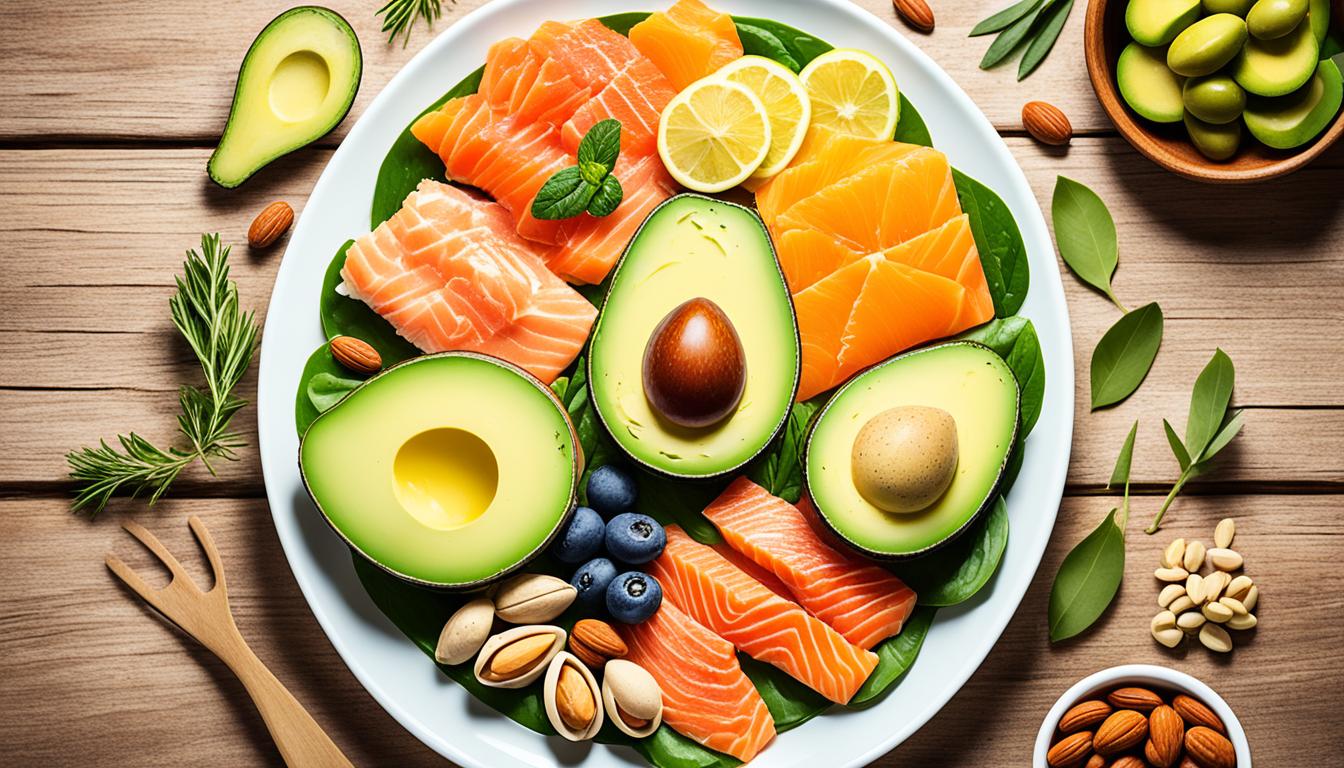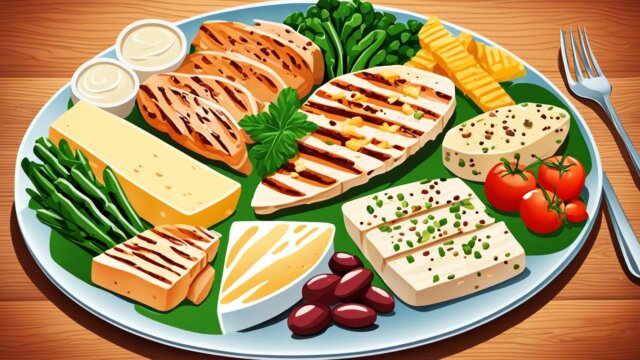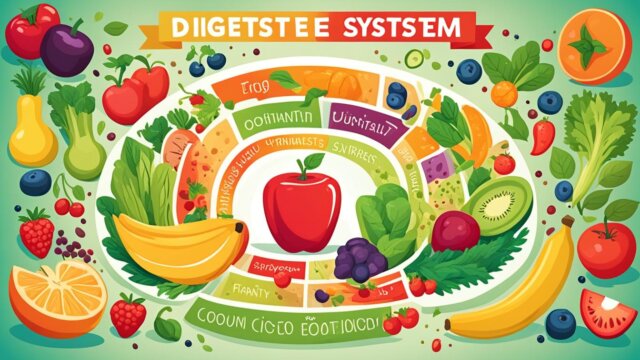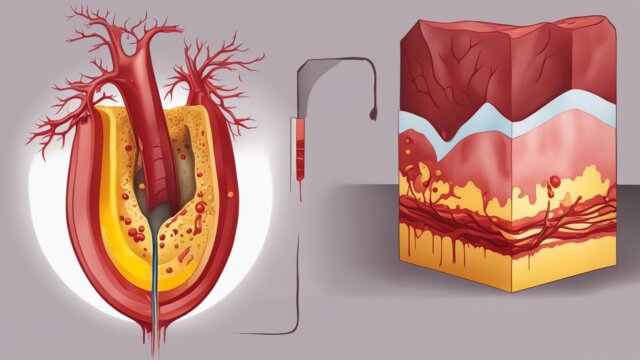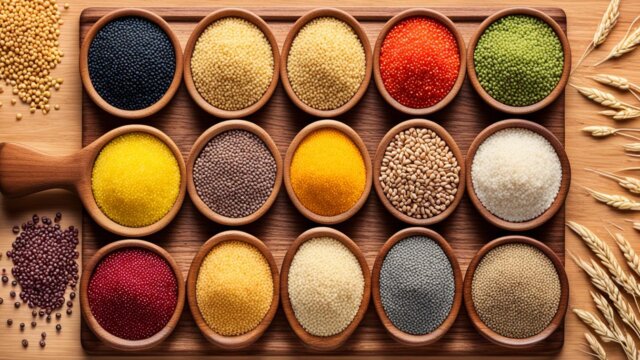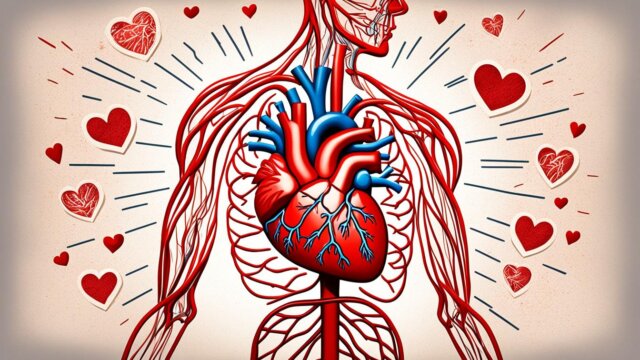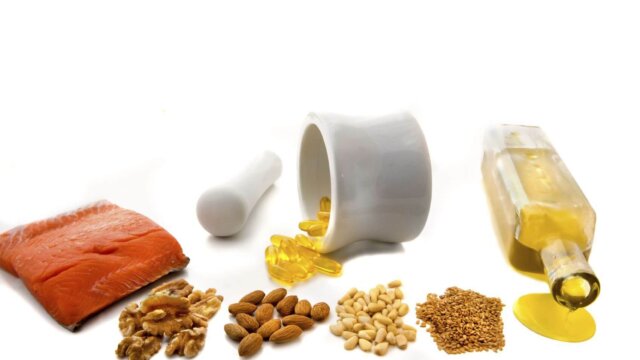FTC disclaimer: This post may contains affiliate links and we will be compensated if you click on a link and make a purchase.
Did you know the American Heart Association (AHA) suggests eating 2 servings of fatty fish weekly? This fact shows how important healthy fats are for our diets. Not all fats are the same, and some high-fat foods are good for us.
Dairy, eggs, and plants like avocados, nuts, and seeds are full of good fats, protein, and fiber. Before, fats were seen as bad. But now, we know that monounsaturated and polyunsaturated fats are good for us. It’s important to eat these healthy fats and avoid bad fats like trans fats and too much saturated fats.
Key Takeaways
- The American Heart Association recommends consuming 2 servings of fatty fish per week for their omega-3 content.
- Avocados, nuts, and seeds are excellent sources of healthy fats that can benefit heart health and reduce inflammation.
- Olive oil and eggs are also great options for incorporating healthy fats into your diet.
- Flaxseeds are a plant-based source of omega-3 fatty acids that can be easily added to your meals.
- Fortified foods like milk and bread provide an alternative way to get omega-3s in your diet.
The Importance of Healthy Fats
Fats are key for the body to work right. Eating foods with healthy fats is good for you. These fats help fight inflammation, lower cholesterol and keep the heart and brain healthy.
They also make you feel full, slow down food digestion, and taste your food better.
Experts say 20 to 30% of your daily calories should come from fats. Saturated fats should be less than 6% of your calories. Foods like cheese, pizza, and burgers are high in saturated fats.
On the other hand, monounsaturated and polyunsaturated fats are good for your heart. They lower bad cholesterol and raise good cholesterol. You can find these fats in avocados, nuts, seeds, fish, and some oils.
Omega-3 and omega-6 fats are must-haves that you can’t make in your body. Eating fatty fish like salmon often can prevent heart disease. But, don’t eat too much fat to avoid gaining weight.
Adding healthy fats to your meals brings many health benefits. It’s good for your overall health and happiness.
Omega-3 Fatty Acids and Their Benefits
Fatty Fish: A Rich Source of Omega-3s
Omega-3 fatty acids (omega-3s) are key for our health because our bodies can’t make them on their own. Fatty fish like salmon, mackerel, herring, lake trout, sardines, and albacore tuna are packed with these important omega-3s. Eating at least two servings of fatty fish each week is good advice from the American Heart Association.
Omega-3s are vital for cell health and are found mostly in eye and brain cells. There are three main types: EPA, DHA, and ALA. EPA and DHA come from fish, while ALA is from plants. These omega-3s help lower bad fats, increase good cholesterol, and might cut down heart disease risk.
Food Source | Omega-3 Content |
|---|---|
Mackerel | 4,580 mg of EPA and DHA per 3.5 oz (100 g) serving |
Salmon | 2,150 mg of EPA and DHA per 3.5 oz (100 g) serving |
Cod Liver Oil | 2,438 mg of EPA and DHA per tablespoon |
Herring | 2,150 mg of EPA and DHA per 3.5 oz (100 g) serving |
Oysters | 329 mg of EPA and DHA per 6 raw eastern oysters or 391 mg per 3.5 oz (100 g) serving |
Sardines | 1,463 mg of EPA and DHA per cup (149 g) of canned Atlantic sardines or 982 mg per 3.5 oz (100 g) serving |
Anchovies | 411 mg of EPA and DHA per 5 anchovies (20 g) or 2,053 mg per 3.5 oz (100 g) serving |
Caviar | 1,046 mg of EPA and DHA per tablespoon (16 g) or 6,540 mg per 3.5 oz (100 g) serving |
While fatty fish are great for omega-3s, be aware of mercury levels in some fish. For those who don’t eat fish, options like flaxseed, chia seeds, and walnuts offer omega-3s too.
“Consuming at least two servings of fatty fish per week can provide a significant amount of omega-3s and offer various health benefits.”
Avocados: A Nutrient-Dense Superfood
Avocados are a special fruit with a lot of fat, about 80% by calories. But, these fats are the good kind, like oleic acid. This fat might help fight inflammation and even prevent cancer. They’re also packed with fiber, potassium, and antioxidants for your eyes.
Avocados are a big deal in the U.S., with thousands of farms producing over 400 million pounds a year. Eating avocados often can make your heart healthier. It can raise good cholesterol and lower bad cholesterol.
Avocados are not just tasty but also very useful in many recipes. They help with weight control, make you feel full, and cut down belly fat.
For pregnant women, avocados are a great choice. They give lots of folate, potassium, vitamin C, and B6. These are key for a healthy pregnancy. Plus, they’re full of “good fat” that can lower cholesterol and heart disease risk.
Adding avocados to your meals is an easy way to get more nutrients and stay healthy. With their great taste and health benefits, avocados are a superfood you should eat more of.
Nuts and Seeds: Packed with Healthy Fats
Nuts and seeds are full of healthy fats that are good for your body. They include nuts like walnuts and almonds, and seeds like chia and flaxseeds. These foods are key for a balanced diet.
Nuts and seeds are not just full of healthy fats. They also have a lot of protein, fiber, vitamins, and minerals. Eating these foods can help lower cholesterol, control blood sugar, and aid in weight management.
Nut Butters: A Convenient Way to Enjoy Nuts
If you love nuts but don’t always have time to snack on them, nut butters are a great option. These creamy spreads have all the healthy fats and nutrients of the nuts they come from. Just remember, nut butters can be high in calories.
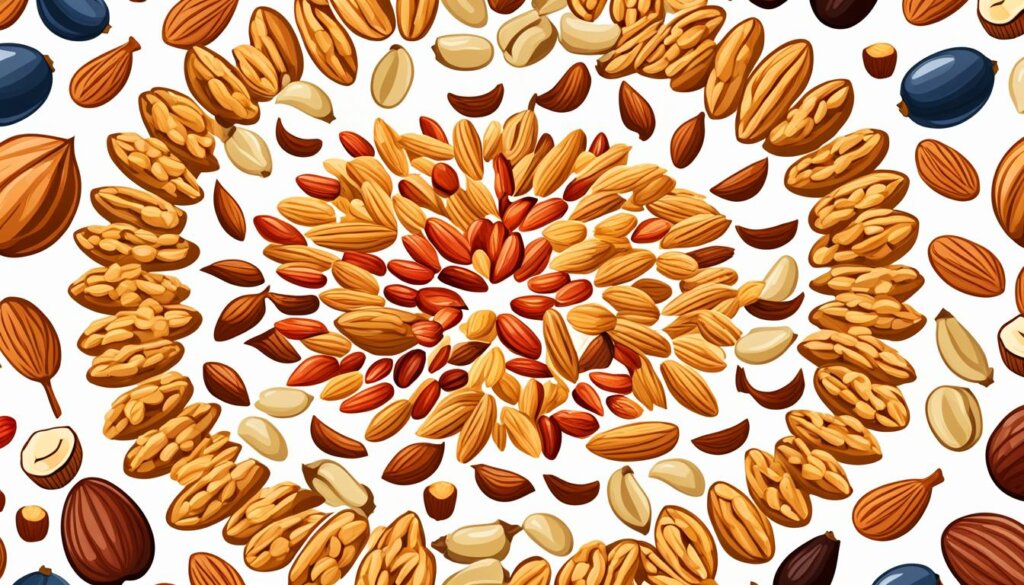
You can enjoy nuts and seeds by themselves, in recipes, or as a spread on toast. These foods are a great way to add healthy fats to your diet.
Olive Oil: A Staple of the Mediterranean Diet
Olive oil is key to the famous Mediterranean diet. It’s full of monounsaturated fats, which keep your heart healthy. People who eat this diet have about 4 tablespoons of olive oil daily. They also eat less butter or cream.
Studies over the last five years have looked into the Mediterranean diet’s health perks. They found that olive oil’s polyphenols help fight inflammation. This can prevent and treat many diseases. The diet’s omega-3 fatty acids also help fight allergies by changing in the gut.
The Mediterranean diet is known for its health benefits. A 15-year study showed it lowers death rates and helps older people live longer. It also cuts down on heart disease and stroke, especially in women.
Olive oil is more than just tasty. It’s full of polyphenols that fight inflammation and act as antioxidants. Adding olive oil to your meals means enjoying great flavor and getting health benefits too.
Eggs: A Nutritious Source of Healthy Fats
Eggs are great for getting protein and healthy fats without spending a lot. Two large eggs give you 11 grams of fat. This includes 3.5 grams of saturated fat, 2 grams of polyunsaturated fat, and 5 grams of monounsaturated fat. All the fat is in the yolk, which also has important nutrients.
Monounsaturated fats are a big part of eggs, with two large eggs having 5 grams. These fats are good for the heart and can lower inflammation. Eggs also have a bit of omega-3 fatty acids. Omega-3 enriched eggs give you about 800mg per two-egg serving.
People used to think eggs were bad because of their cholesterol. But now, studies show that eggs don’t really raise blood cholesterol in most people. Eggs are also packed with vitamins, minerals, and choline. Choline is key for brain and nerve health.
Eggs don’t have trans fats, unlike many processed foods that do. These trans fats are bad for your health. Adding eggs to your meals means you get tasty and healthy fats and other important nutrients.
Nutrient | Amount per Serving (2 Large Eggs) |
|---|---|
Total Fat | 11 g |
Saturated Fat | 3.5 g |
Monounsaturated Fat | 5 g |
Polyunsaturated Fat | 2 g |
Omega-3 Fat | 0.2 g |
Omega-6 Fat | 1.5 g |
Trans Fat | 0 g |
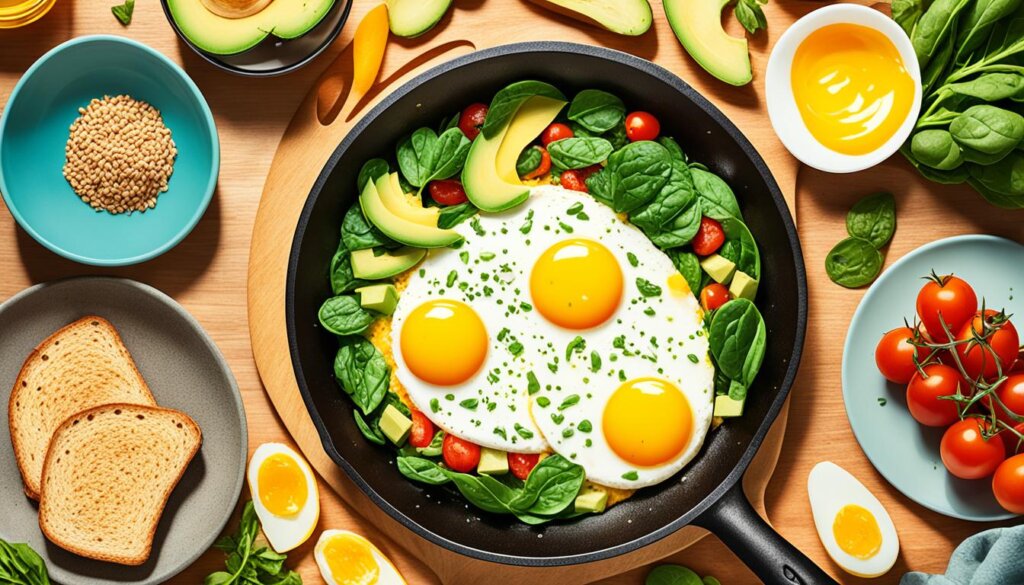
Eggs are a good source of dietary fat, mostly unsaturated fats. The UK government says it’s okay to eat eggs as part of a healthy diet.
Flaxseeds: A Plant-Based Source of Omega-3s
Flaxseeds are a great plant-based source of omega-3 fatty acids, especially alpha-linolenic acid (ALA). These small seeds are packed with nutrients. They offer many health benefits, making them a great choice for any diet.
Incorporating Flaxseeds into Your Diet
Adding flaxseeds to your daily meals is an easy way to get more omega-3s. Just one tablespoon of ground flaxseeds gives you 2,350 mg of ALA. That’s 146–213% more than you need. You can put them on cereal, yogurt, or salads, or mix them into your baked goods for a tasty crunch.
Flaxseeds are easy to add to many dishes. They have a nutty taste and a crunchy texture. Enjoy them whole, ground, or as flaxseed oil to get your omega-3s.
Flaxseed Nutrition Facts (per 100g) | Amount |
|---|---|
Calories | 534 |
Total Fat | 42g |
Carbohydrates | 29g |
Fiber | 27.3g |
Protein | 18g |
Flaxseeds are full of omega-3s and other nutrients like fiber, protein, and plant compounds. Adding these versatile seeds to your meals is a tasty way to support your health and well-being.
Beans: A Surprising Source of Omega-3s
Beans might not seem like a top choice for healthy fats. But, they are actually a great source of omega-3 fatty acids. Adding beans like kidney, Great Northern, navy, or soybeans to your meals can boost your health.
Beans are full of protein, fiber, and other important nutrients. They also have omega-3s, which are key for brain health and overall well-being. A half-cup of cooked kidney beans gives you about 15% of the omega-3s you need each day.
- Beans are a good source of ALA, which can turn into EPA and DHA, though not much.
- Soybeans are especially good, giving you about 25% of your daily ALA needs.
- Navy and Great Northern beans also have a good amount of omega-3s. They’re a cheap and easy way to get these fats.
So, when you want to add healthy fats to your meals, think about beans. They’re great for your brain and overall health. These simple legumes are full of omega-3s.
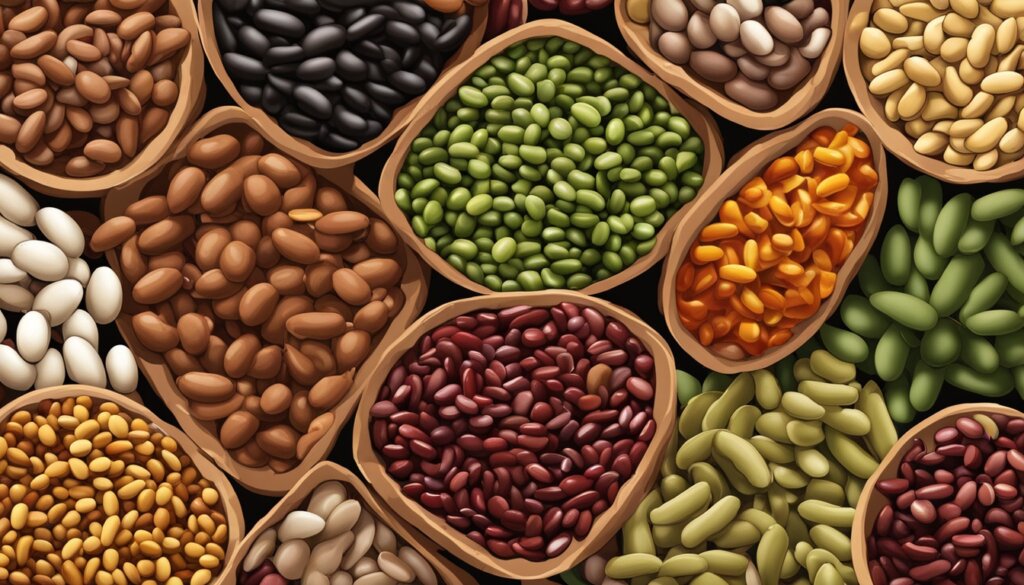
“Beans are a superfood, packed with fiber, protein, and now we know, omega-3s. They’re a budget-friendly way to get these essential nutrients into your diet.”
Fortified Foods: An Alternative Way to Get Omega-3s
If you want to increase your omega-3 levels, try fortified foods. Foods like enriched milk, eggs, bread, and bars are good sources of these fats. They offer a natural way to get omega-3s, unlike supplements.
These foods are great for people who find it hard to get enough omega-3 from food. The FDA says don’t take more than 5 grams of EPA and DHA a day from supplements. The American Heart Association suggests about 1 gram a day for heart health.
Adding omega-3 fortified foods to your meals is easy and helpful for your health. They can help your heart, lower cancer risk, and keep your brain sharp. But remember, they shouldn’t replace a full, healthy diet.
Always talk to a doctor before taking any supplements or fortified foods, especially if you have health issues or take other medicines. With omega-3 fortified foods, you can get health perks while eating well.
Dark Chocolate: A Treat with Healthy Fats
Dark chocolate is a treat that’s good for you. It’s full of healthy fats and nutrients. Dark chocolate with 70% or more cocoa is especially good. It has less sugar and more antioxidants and minerals.
A 100-gram bar of dark chocolate with 70–85% cocoa has 11 grams of fiber. It also has 66% of the daily value for iron, 57% for magnesium, 196% for copper, and 85% for manganese. It’s full of antioxidants like polyphenols, flavanols, and catechins.
The healthy fats in dark chocolate are good for you. They can make your blood flow better and lower your blood pressure a bit. Eating dark chocolate a few times a week might cut your risk of heart disease by up to 11%. It can also protect you from the sun better.
Dark chocolate is also good for your brain. Eating cocoa can make you think better by improving blood flow. It has caffeine and theobromine, which can help you feel more alert. A 3.5-ounce serving of dark chocolate with 70%-85% cacao has 80 milligrams of caffeine, less than an 8-ounce cup of coffee.
But remember, dark chocolate should be eaten in small amounts. A 1/4 cup serving has 220 calories, 13 grams of fat, 24 grams of carbs, and 18 grams of sugar. The American Heart Association says to limit added sugar to 25-36 grams a day. Some dark chocolate bars may also have lead and cadmium, which are harmful metals.
Dark chocolate can be a tasty and healthy choice if eaten in moderation. Its healthy fats, antioxidants, and other good stuff make it a treat. Just pick high-quality, less processed kinds and watch how much you eat.
Healthy Fats Foods and Weight Management
Not all fats are bad for your health. Some healthy fats help with weight management. Studies show that eating whole foods with lots of fat can be good for you.
Nuts are great for weight control because they’re full of healthy fats and other nutrients. Avocados are mostly fat but are also a superfood for weight management.
Fatty fish like salmon are full of omega-3 fatty acids. These fats fight inflammation and keep your heart healthy. The USDA says to eat 8 ounces of fatty fish a week for these benefits.
Adding healthy fats like olive oil, eggs, and dark chocolate to your diet helps with more than just weight. They protect your heart and support gut health.
Choose whole foods rich in healthy fats over processed, high-fat foods. Making smart choices helps your health and weight goals.
Monounsaturated and Polyunsaturated Fats: The Healthy Fats
Not all fats are the same. Monounsaturated and polyunsaturated fats are good for you. They help fight inflammation, lower cholesterol and keep your heart and brain healthy.
Identifying Unhealthy Fats
Unhealthy fats include saturated and trans fats. These fats should make up less than 10% of your daily calories. Too much can increase heart disease and stroke risk. The American Heart Association suggests even less, about 5% to 6% of daily calories from saturated fats. Trans fats are made in labs and are no longer seen as safe by the FDA.
Healthy fats are usually liquids at room temperature. Unhealthy fats like butter and lard are solids. Knowing the difference helps you eat better.
The Benefits of Healthy Fats
Plant-based monounsaturated fats can lower bad cholesterol and raise good cholesterol. Polyunsaturated fats include omega-6 and omega-3 fatty acids. Omega-6 fats can lower bad cholesterol and triglycerides, raise good cholesterol, and help control blood sugar. Omega-3 fats from fish can lower triglycerides and reduce heart and blood vessel diseases risk.
Every gram of fat has 9 calories. So, eat fats in moderation for a balanced diet.
Healthy Fats | Unhealthy Fats |
|---|---|
Monounsaturated fats (73% of recommended daily value in olive oil) | Saturated fats (e.g., butter, lard) |
Polyunsaturated fats (e.g., omega-3s in fatty fish, omega-6s in walnuts) | Trans fats (artificially created, no longer recognized as safe) |
Liquid at room temperature | Solid at room temperature |
Knowing the difference between healthy and unhealthy fats helps you make better choices for your health.
Incorporating Healthy Fats into Your Diet
Adding more healthy fats to your meals can greatly improve your health. Experts say 20-35% of your daily calories should come from fats, mostly unsaturated ones. These fats, found in plant oils, nuts, avocados, and fatty fish, help lower heart disease risk.
To get more healthy fats, swap butter or margarine with olive, canola, or avocado oil when cooking. Add nuts, seeds, or avocado to your meals. Eat fatty fish like salmon a few times a week. Just a bit of these foods can give you a lot of healthy fats.
When shopping, check food labels for unsaturated fats like monounsaturated and polyunsaturated ones. Choose low-fat dairy and lean meats to cut down on bad fats.
Healthy Fat Source | Serving Size | Healthy Fat Content |
|---|---|---|
Olive Oil | 2 teaspoons | 9-10g |
Nut Butter | 4 teaspoons | 10g |
Nuts | 1/2 ounce | 10g |
Cheese | 1 ounce | 10g |
Avocado | 1/3 avocado | 10g |
Tuna (oil-packed) | 5 ounces | 10g |
Sardines (oil-packed) | 3 ounces | 10g |
Chia Seeds | 1 ounce | 9g |
Flax Seeds | 1 ounce | 10g |
Pumpkin Seeds | 5 teaspoons | 10g |
Olives | 20 olives | 10g |
Adding healthy fats should be done carefully. Talk to a health expert to find the right amount for you and your health goals. Signs you need more healthy fats include dry hair, hair loss, dry skin, and brittle nails.
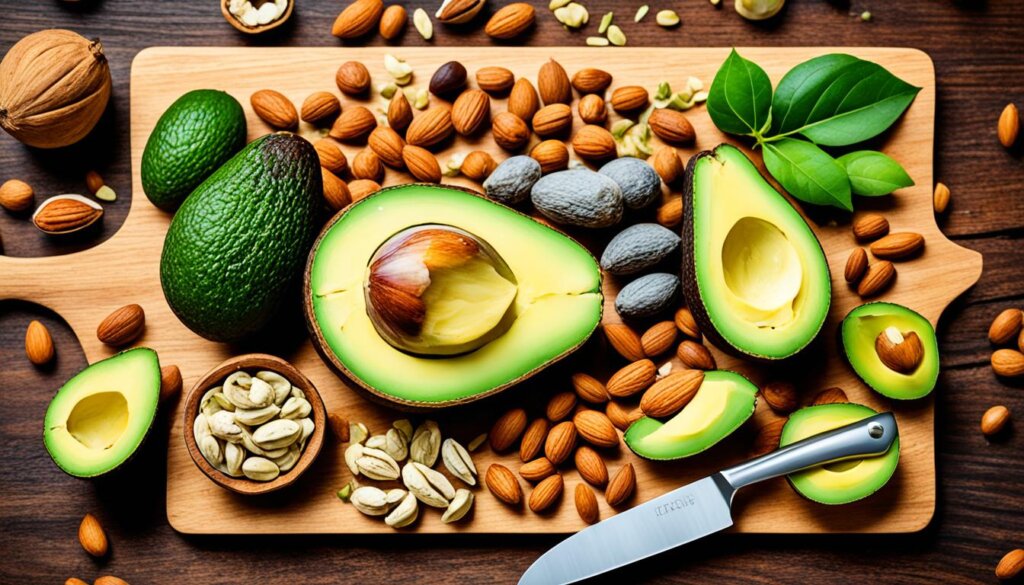
“Healthy fats play a vital role in overall wellness, from nutrient absorption to disease prevention. By making simple swaps and additions to your meals, you can reap the benefits of these essential nutrients.”
– Ryanne Lachman, Registered Dietitian
Conclusion
Healthy fats are key for a balanced diet. They help your heart and brain and fight inflammation. Foods like fatty fish, avocados, nuts, seeds, and olive oil are great sources. Adding these fats to your meals boosts your health. Just remember to eat them in moderation and choose whole foods over processed ones.
Over time, people have changed what they eat, focusing on healthy diets. We’re learning more about fats and how they affect our health. Eating healthy fats can make you feel better overall.
It’s clear how vital the summary of healthy fats, the importance of healthy fats, and incorporating healthy fats are. By choosing wisely, you can help your heart, brain, and health. Keep learning about healthy fats and how to add them to your life for better health.
FAQ
What are some healthy fat-rich foods?
Healthy fats are found in fatty fish, avocados, nuts, seeds, olive oil, and eggs.
What are the health benefits of healthy fats?
Healthy fats help fight inflammation and lower cholesterol. They support heart and brain health.
How much omega-3 fatty acid should I get?
The American Heart Association suggests eating two servings of fatty fish weekly. This includes salmon, mackerel, or tuna.
What makes avocados a superfood?
Avocados are full of healthy fats, fiber, potassium, and antioxidants. These can help eye health.
What are the health benefits of nuts and seeds?
Nuts and seeds offer healthy fats, protein, fiber, vitamins, minerals, and antioxidants. These can lower cholesterol and support health.
How is olive oil good for the heart?
Olive oil has monounsaturated fats that can lower heart disease risk and cardiovascular issues.
Are eggs healthy despite their cholesterol?
Yes, eggs are nutritious with protein and healthy fats. The cholesterol in eggs doesn’t raise blood cholesterol for most people.
How can I incorporate more flaxseeds into my diet?
Add ground flaxseed to cereals, yogurt, salads, baked goods, and other dishes. This boosts fiber and omega-3 intake.
Do beans contain omega-3s?
Yes, beans are a plant-based omega-3 source. They help with mood and offer health benefits.
Why are fortified foods a good way to get omega-3s?
Fortified foods like milk, eggs, and breads offer omega-3s naturally, unlike supplements.
How can dark chocolate be a healthy fat?
Dark chocolate with 70% cocoa is rich in fiber, minerals, and antioxidants. Its fat comes from healthful cocoa butter.
Can healthy fats help with weight management?
Yes, healthy fats like nuts can help with weight loss and reduce obesity risk.
What are the differences between healthy and unhealthy fats?
Healthy fats are liquid at room temperature. Unhealthy fats like saturated and trans fats are solid.
How can I easily add more healthy fats to my meals?
Use olive oil instead of less healthy fats when cooking. Add nuts, seeds, or avocado to dishes. Enjoy fatty fish a few times a week.
